DUAL ACCESS
REGIONAL PARTNER LABORATORIES
A new access mode
In the frame of the ISABEL project, EMFL will trial a novel dual access procedure which will invite users at an early stage of their research projects and will lower the barrier for access as well. Within one experiment proposal, users will have the possibility to apply both :
- for first-step access to research equipment dedicated to the moderate-field range accessible with superconducting magnets,
- and in a subsequent second step to the highest possble magnetic fields at the EMFL installations in Grenoble, Nijmegen, Toulouse and Dresden.
For performing experiments in the moderate-field range, thanks to the ISABEL project, EMFL has partnered with well-equipped and experienced regional facilities distributed over Europe.
Who and where?
In total, ISABEL has gathered 7 regional partners facilities:

- Superconducting magnet laboratory, University of Nottingham (UNOT)
- Oxford Centre for Applied Superconductivity, University of Oxford (UOXF)
- Nicholas Kurti High Magnetic Field Laboratory, University of Oxford (UOXF)
- Laboratory of Low Temperatures and High Magnetic Fields, Universidad Autonoma de Madrid (UAM)
- Research Laboratories of the Faculty of Physics, University of Warsaw (UWAR)
- Materials Growth and Measurement Laboratory, Charles University, Prague (UCHA)
- Research Facilities of the National Institute of Chemical Physics and Biophysics, Tallinn (NICPB)
- Spintronics and Nanomagnetism Laboratory, University of Salento, Lecce (USAL)
Regional partner facilities map/ © Bernd Schröder
THE LABORATORIES
Local contacts
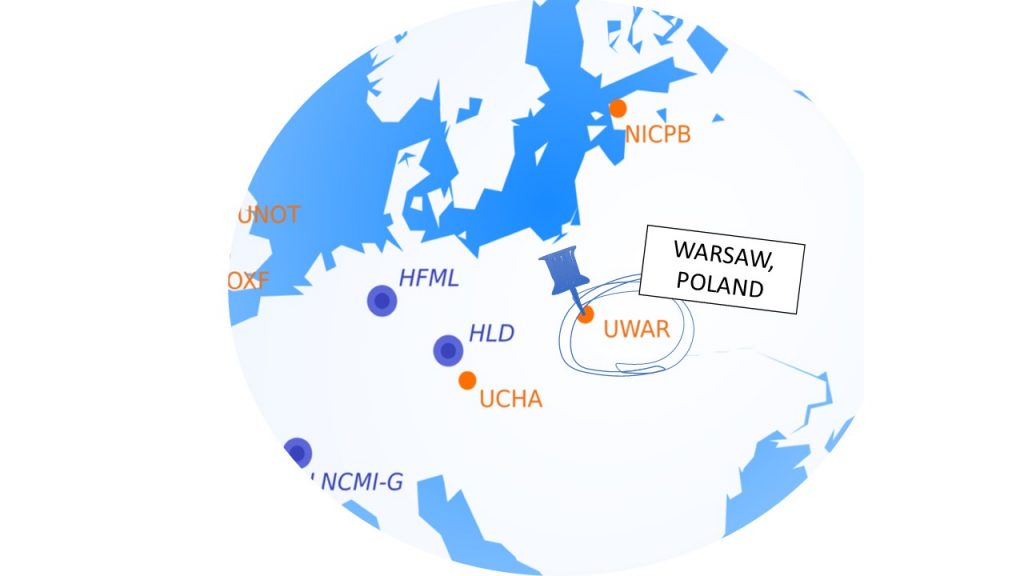
- Dr Tomasz Kazimierczuk (Tomasz.Kazimierczuk@fuw.edu.pl)
- Dr hab. Marta Borysiewicz (Marta.Gryglas@fuw.edu.pl)
- Dr Maciej Molas (Maciej.Molas@fuw.edu.pl)
Description
The infrastructure is located in several laboratories of the Faculty of Physics. The laboratories excel in the following areas:
1.. Optical spectroscopy in magnetic field
Available superconducting magnets:
- 16 T magnet for experiments in Faraday configuration,
- 10 T magnet for experiments in Faraday or Voigt configuration,
- 3T two-coil vector-rotate magnet allowing smooth transition from Faraday to Voigt geometry or in-plane rotation of the magnetic field in the Voigt geometry.
Each magnet is equipped with variable-temperature insert (VTI) allowing measurements from room temperature down to pumped helium (about 1.5 K). Persistent switches at superconducting coils, allow for extended stay at a single field in addition to regular field-sweep measurements.
Available techniques:
- Reflectivity and transmission,
- Raman scattering,
- Photoluminescence (PL, PLE)
with variety of lasers: 325 nm, 405 nm, 425 nm, 457 nm, 488 nm, 515 nm, 532 nm, 561 nm, 575-625 nm (tunable), 647 nm, 685 nm, 700-860 nm (tunable), 808 nm.
Typical signal detection using Si CCD camera (400-1000 nm). InGaAs detector (up to 1700 nm) available upon request.
- Time-resolved PL:
– Excitation using femtosecond laser near 400 nm, or between 600 and 950 nm (tunable),
– Detection using streak camera (S1 or S20 cathode, temporal resolution down to 3 ps), or
– Detection using APD (quantum efficiency higher than streak camera, temporal resolution down to 50 ps).
- Photon correlations using Si APDs,
- Ultrafast pump-probe spectroscopy (details upon request).
Samples:
- By default the investigated samples are probed locally using NA>0.5 lens or objective, which corresponds to the spot of 1-2 µm,
- The samples should not be larger than about 8 mm x 8 mm,
- Voltage control for gated samples is available.
For more information, contact:
→ Dr Tomasz Kazimierczuk (Tomasz.Kazimierczuk@fuw.edu.pl)
→ Dr Maciej Molas (Maciej.Molas@fuw.edu.pl)
2.. Electric transport in magnetic field
Available superconducting magnets:
- Oxford Instruments cryostat with a variable temperature insert (1.5 K – 300 K) and magnetic field of (12 T),
- Dilution fridge unit Oxford Instruments Kelvinox with temperature range (20 mK – 1 K) and magnetic field of 16 T.
In both setups probes with rotators may be used, enabling variation of sample plane with respect to magnetic field.
Available techniques:
- Hall effect measurements for metallic to semiconducting samples,
- Low current measurements (down to pA) may be performed.
For more information, contact
→ Dr hab. Marta Borysiewicz (Marta.Gryglas@fuw.edu.pl)
Local contact
→ Prof. Dr. Hermann Suderow (hermann.suderow@uam.es)
→ Dr. Isabel Guillamón (isabel.guillamon@uam.es)
Description
The campus of the Universidad Autonoma de Madrid (UAM) hosts a large number of operating superconducting magnets and a functional large Helium liquefaction facility. The researchers at UAM have ample experience in the characterization of quantum materials under magnetic fields, particularly in Tunneling Microscopy at high magnetic fields. There is also experience in magnetotransport probes.
Services currently offered
Services needed to prepare experiments in EMFL facilities are available, including magnetotransport, Scanning Tunneling Microscopy. Other probes which can be considered upon request. The UAM hosts vectorial (5+1+1) magnets as well as 17 T and a 22 T magnet. There are a number of magnets producing fields up to 12 T. The UAM hosts five functional dilution refrigerator units, reaching temperatures from 10 mK to 50 mK.
Local contact
→ Jan Prokleška (prokles@mag.mff.cuni.cz)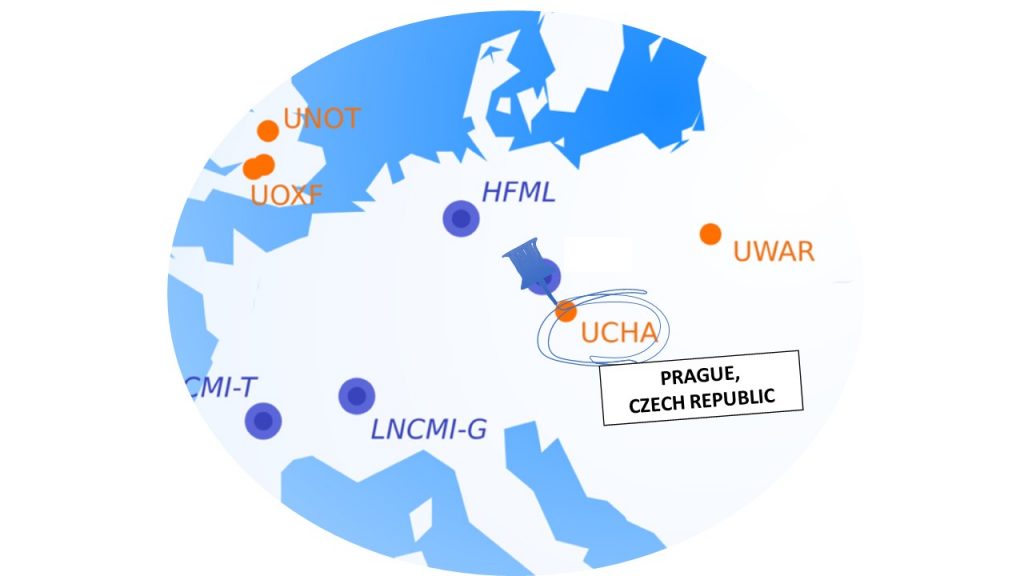
Description
The Materials Growth and Measurement Laboratory (MGML) is a large research infrastructure operated by the Faculty of Mathematics and Physics, Charles University in cooperation with the Institute of Physics of Czech Academy of Sciences. The main focus is the condensed matter physics and materials research. More specifically, it involves the studies of novel electronic states, phase transitions including quantum phase transitions, topological insulators and superconductors, magnetism and unconventional superconductivity, ferroic, multiferroic, magnetocaloric or magnetic shape-memory materials.
Services currently offered
MGML offers open access to its services to users from the basic and applied research areas. Details of all the instrumental equipment, including compatible sample environment, can be found on the webpage.
The services for the measurement of material properties include magnetization, AC magnetic susceptibility, heat capacity, electrical resistivity, magnetoresistance, electrical capacity, permittivity, magnetoelectric response, Hall resistivity, thermal conductivity, Seebeck effect, thermal expansion, magnetostriction, AFM, MFM or PFM.
The suite of magnets, cryostats, and pressure cells enables to carry out these measurements in magnetic fields up to 19.5 T, in a broad temperature interval from 30 mK up to several hundred degrees Celsius, electric fields from -50V to + 50V, and hydrostatic and uniaxial pressures up to 15 GPa.
In addition, MGML offers services for synthesis and characterization of materials – metals, intermetallics, semimetals, oxides or inorganic salts. Several complementary techniques are available for crystal growth: Czochralski, Bridgman, floating-zone (mirror or laser furnace), flux-growth, chemical vapor transport, hydrothermal growth. Modern DTA/DSC analysis, scanning electron microscopes and broad range of X-ray diffraction instruments (operating in the range of 3 – 1200 K) allow detailed structural and phase characterization of samples.
The services to users are supported by a high-expertise advice and assistance of the scientific and technical MGML staff. The remote online access is possible for majority of our instruments.
MGML holds an official license for onsite manipulation of materials containing U and Th for research purposes, allowing the synthesis and measurement of materials containing these elements.
Local contact
→ Professor Amalia Coldea (Amalia.Coldea@physics.ox.ac.uk)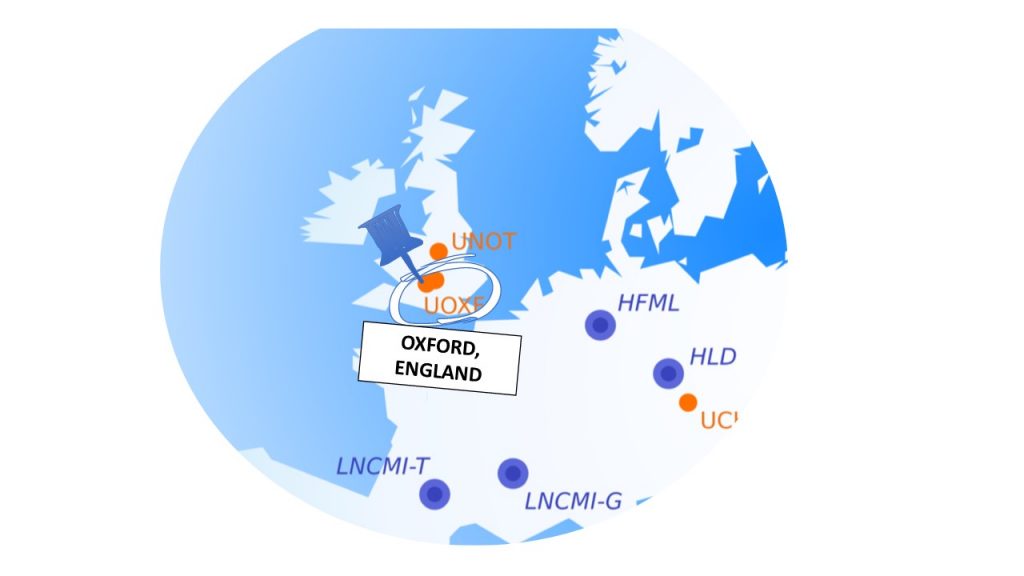
Description
The Oxford Centre for Applied Superconductivity (CFAS) was recently set up in January 2017 based on an investment by the Local Growth Funding through Oxfordshire County Council and the Oxfordshire Local Enterprise Partnership as well as by the University of Oxford and local industrial partners working on superconductivity which includes Oxford Instruments and Siemens (~ 4.5M€).
The Centre is a Superconductivity Hub with interests in future applications of superconducting materials which aims to pursue projects that can lead to future technologies and lead to the discovery of novel superconducting materials. The Centre helps to train people with necessary skills in superconductivity which can be transferable to other relevant industries. Currently, the Centre is developing a series of experimental and testing facilities in a new purpose built laboratory equipped with a modern 16T Physical Properties Measurement System (PPMS) for testing the magnetic and transport properties of new superconducting materials and a 17T magnet and high current power supplies to test superconducting wires and tapes up to 1200 A relevant for applications in industry. This 16T PPMS is a user facility and runs 24 hours per day, 7 days per week, and it has a very large user base being used for characterization of novel superconducting and topological single crystalline samples.
The areas of research normally pursued at this facility include fundamental and critical studies of novel superconducting materials, fermiology and magnetotransport studies of new single crystalline materials. New techniques, such as applied pressure up to 30kbar and a tunnel diode oscillation system, have been recently developed for the PPMS up to 16T and down to 1.7K. These low field studies constitute an important part for the successful experiments and time allocation at high field facilities of EMFL and elsewhere.
Oxford also benefits from a large number of superconducting high magnetic fields which form a local High Magnetic Field facility with fields up to 21T and equipped with variable temperature inserts and dilution refrigerators for transport, optical and thermodynamic studies.
Local contacts
→ Professor Stephen Blundell (Stephen.Blundell@physics.ox.ac.uk)

Description
Oxford University hosts the Nicholas Kurti Magnetic Field Laboratory, which is a local pulsed field facility which could allow the running of three experimental magnet cells, which are powered by a configurable capacitor bank with maximum energy storage up to 3MJ. Pulsed magnets are designed and wound in-house and have achieved fields up to 50 – 60 T. Pulse lengths of the order of 10 ms can be adjusted by changing the configuration of the capacitor bank and repetition times are under an hour for full field shots. Non-standard and custom-made magnets are also available with longer pulse lengths, but typically at the cost of peak field.
The pulsed field laboratory has been recently upgraded with a new capacitor bank from 0.8MJ to 3MJ and it is in advance testing phase towards completion. A new 70T magnet has been built to be tested using the new upgraded facilities.
Experimental capabilities contain compensated coil magnetometry for the measurements of absolute magnetization in milligram samples of magnetic material. This technique is highly sensitive to magnetic phase transitions and energy level crossings. The electronic behaviour of metallic and superconducting systems can be investigated by resisitivity, skin-depth and penetration using contacted and contactless methods. Furthermore, measurements of the Fermi surface of conducting materials using de Haas-van Alphen and Shubnikov-de Haas quantum oscillation effects are possible using 3He refrigerators enable experiments to take place at temperatures down to 400 millikelvin.
Local contact
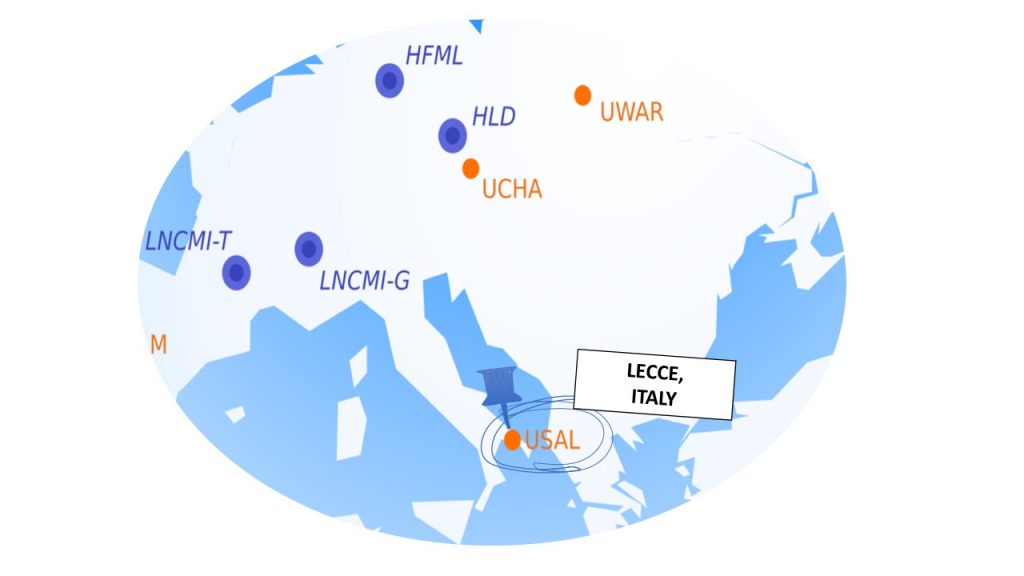 → Prof. Giuseppe Maruccio (giuseppe.maruccio@unisalento.it)
→ Prof. Giuseppe Maruccio (giuseppe.maruccio@unisalento.it)
Description
The Spintronics and Nanomagnetism Laboratory at University of Salento is located in joint laboratories with CNR-Institute of Nanotechnology and includes:
- A Cryogenic Ltd superconducting magnet (10.5 Tesla, 0.3-300 K) equipped for variable temperature magnetotransport, magnetometry and ac susceptibility measurements.
- An Oxford superconducting vector magnet (6T/1T/1T) with dilution refrigerator reaching temperatures down to 10 mK, equipped for DC transport, RF and FMR measurements.
- A cryogenic probe station for DC and RF (up to 70 GHz) measurements in moderate field.
- An Oxford superconducting magnet (8T) with a custom-built optical cryostat for magneto-optical spectroscopies.
The related research activities are multidisciplinary and span from spintronics and magnetotransport to magnonics and magneto-optical spectroscopy, from the characterization/optimization of novel sensors to material sciences, nanomagnetism and novel functional magnetic materials (such as multiferroics). Expansion plans include equipment for THz measurements and low temperature scanning probe microscopy/spectroscopy.
Services currently offered
The Spintronics and Nanomagnetism Laboratory is hosted within the joint laboratories among University of Salento and CNR-Institute of Nanotechnology, which represent one of the largest Nanotechnology infrastructure in Italy. Notably, the infrastructure includes also fully equipped clean room for nanofabrication and material growth, nanochemistry, photonics and biology facilities providing an ideal location for multidisciplinary and applied research for in-house and visiting researchers before translating the experiments to the largest EMFL facilities when higher magnetic fields are required. R
esearch highlights include the demonstration of sign reversal of magnetoresistance in tunnel junctions with nanocrystal superlattices and the discovery of electrostatic spin crossover in insulating molecules with super-exchange magnetic interaction and inversion symmetry breaking (with publications on high impact factor journals such as Nat. Mat., Nano Letters, ACS-Nano). Research activities and achievements are disseminated to schools, general public and (yearly) within the European Researchers’ Night. Research is funded by EU, national and regional projects.
Local contact
→ Prof. Raivo Stern (raivo.stern@kbfi.ee)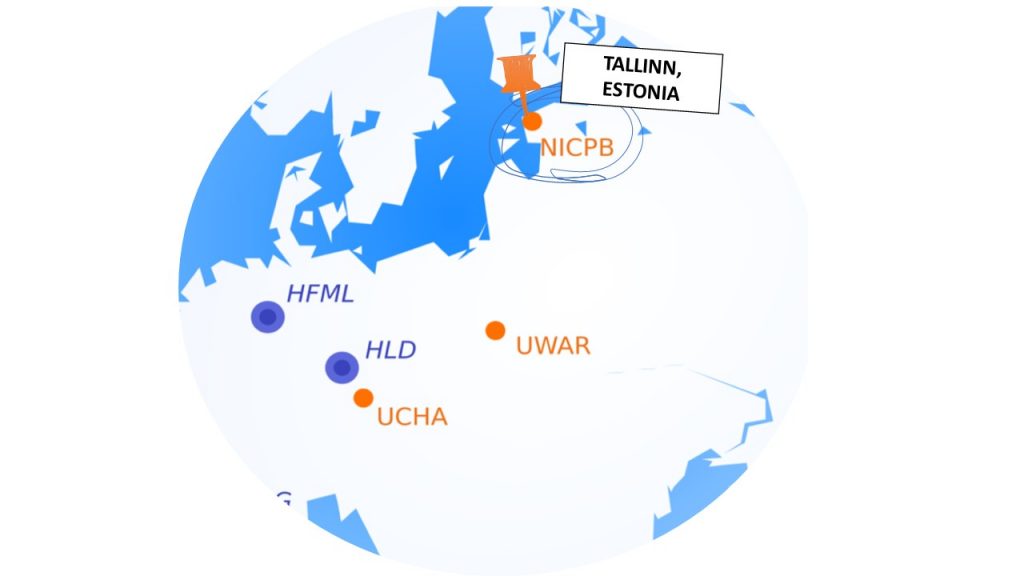
Description
The core of the infrastructure – most of NMR spectrometers and probes, 14T PPMS and THz lab are located in Tallinn, adjacent to theTUT campus, in the Laboratory of Chemical Physics of NICPB. Thre are a 7T ICR and 700MHz NMR in Tartu, at the Institute of Chemistry of UT, and 400MHz NMR machine(s) at TUT.
The Chemical Physics laboratory of NICPB runs several high level NMR instruments, and unique THz and FIR spectrometers, a rather rare 14T PPMS based vibrating sample magnetometer and a unique magnetic/atomic force microscope set-up. We also have a suite of cryostats giving access to several decades in temperature, all backed by the in-house helium liquefier. THz lab has THz spectrometer equipped with 0.3K bolometers for sensitive detection. The sample environment includes a 17T SC solenoid and sample temperature down to 2.5K and a 12T solenoid with dilution fridge where the lowest temperature is 100mK. A range of NMR spectrometers up to 800 MHz is available for solid state and high-resolution NMR. Unique features include the possibility to work down to lHe temperature under magic angle spinning conditions. Collectively, these instruments allow to explore magnetism and magnetic interactions over a large phase space along the three principal axes of frequency, temperature and magnetic field. The 700MHz NMR set-up in Tartu allows some unique liquid-state spinning experiments. The 7T ICR is connected to cropatographs allowing to monitor quite complex chemical teactions. The 400MHz NMR spectrometer(s) at TUT employ massive sample exchangers allowing automatic screening of rather high number of samples.
Services currently offered
Services currently offered
Currently, there are several returning users from EU – Budapest for THz, and Southampton for NMR. Other, rather random users include Helsinki, Turku, Stockholm, Ljubljana, Krakow, and Moscow. for PPMS Tartu and Lappenranta. The most used is the THz lab with their options, but also the cryoMAS and even static NMR has been widely used. The PPMS serves as the magnetometer for the entire northern Baltic region and is a rare option even for groups of Sweden and Finland.
As materials, mostly multi-ferroics and superconductors, but also thin ALD films of oxides and doped fullerenes have been measured and the results published.
Local contact
→ Dr Richard Hill (Richard.Hill@nottingham.ac.uk)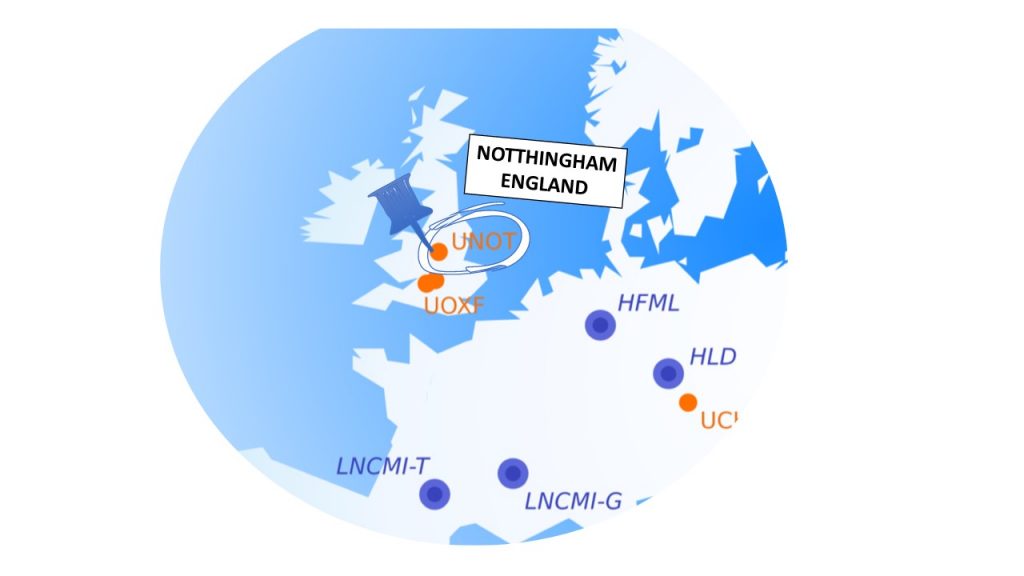
Description
The University of Nottingham magnetic levitation laboratory consists of two superconducting magnets (18.3 Tesla and 16.5 Tesla) situated in a purpose-built laboratory. Both magnets have been custom-built to perform experiments using the technique of diamagnetic levitation to mimic weightlessness and novel differential gravity environments.
The areas of research normally pursued in this laboratory include fluid and granular physics, and biological behaviour studies in weightlessness, but could also be used for solid-state samples with the addition of a suitable insert.
The unique design of these room-temperature-bore magnets allows convenient access to the high field gradient region of the magnetic field, where the diamagnetic forces on liquids such as water, plastics and biological material can be harnessed to counteract the force of gravity at the molecular level.
These magnets can be run for extended periods at maximum field allowing long duration (up to several days) ‘microgravity’ experiments to be performed. The continuous running mode allows for extensive testing and improvement before translating the experiment to the shorter duration experiments typically undertaken in the high field facilities of EMFL.
Services currently offered
Services currently offered
- Oxford Instruments 16.5 T superconducting magnet.
- 50 mm diameter, room temperature bore.
- Cryogenic Ltd. 18.3 T superconducting magnet.
- 58 mm diameter, room temperature bore.

